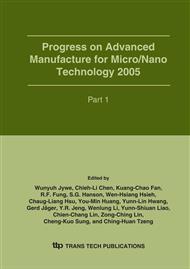p.181
p.187
p.193
p.199
p.205
p.211
p.217
p.223
p.229
Study on the Predictive Model for Shear Strength in Laser Welding Stainless Steel
Abstract:
A predictive model is presented for the prediction of shear strength in laser welding AISI304 stainless steel. Welding experiments conducted using a pulsed Nd:YAG laser machine while the laser welding parameters and their levels have been arranged according to design of experiments of Taguchi method. The tensile tests are performed after welding and the measurements of tensile strength are further calculated for shear strength. The data can be analyzed using the principles of Taguchi method for determining the optimal laser welding parameters and for investigating the most significant laser welding parameter on shear strength. Furthermore, the results are treated as the training and recalling patterns for constructing a predictive model using back-propagation neuron network to predict shear strength for the range of laser welding operation tested. It is indicated that welding speed is the most significant affecting parameters on shear strength. In addition, an increase in welding speed causes a decrease in shear strength is found. An average error 5.75%for shear strength can be found by comparing the experimental results obtained from conducting verification tests with the predicting values obtained from the established predictive model. It shows that the predictive model is capable of good predicting behavior of laser welding AISI304 stainless steel.
Info:
Periodical:
Pages:
205-210
Citation:
Online since:
January 2006
Authors:
Price:
Сopyright:
© 2006 Trans Tech Publications Ltd. All Rights Reserved
Share:
Citation:


